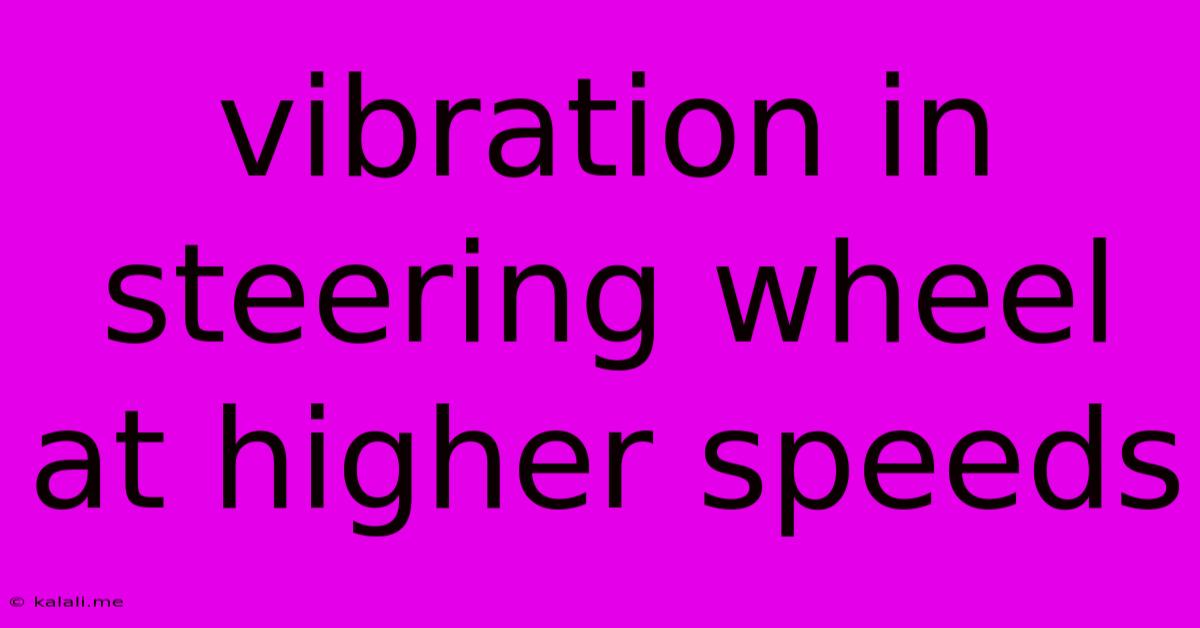Vibration In Steering Wheel At Higher Speeds
Kalali
May 19, 2025 · 3 min read

Table of Contents
Vibration in Steering Wheel at Higher Speeds: Causes and Solutions
Meta Description: Experiencing steering wheel vibrations at higher speeds? This comprehensive guide explores common causes, from tire issues to suspension problems, and offers practical solutions to restore a smooth ride.
Feeling a tremor in your steering wheel as you accelerate past a certain speed? This unsettling vibration isn't just uncomfortable; it can also indicate a potential safety hazard. This article delves into the common culprits behind steering wheel vibrations at higher speeds, helping you diagnose the problem and get back on the road with a smooth, stable ride.
Common Causes of Steering Wheel Vibration at Higher Speeds
Several factors can contribute to vibrations felt in the steering wheel, especially at higher speeds. Let's explore some of the most frequent causes:
1. Tire Problems: This is often the primary suspect. Several tire-related issues can induce steering wheel vibrations:
- Uneven Tire Wear: Worn or unevenly worn tires, particularly if the wear is significant or localized (like cupping or feathering), will cause noticeable vibrations. Inspect your tires carefully for uneven tread depth and any unusual patterns.
- Tire Balance: An imbalance in one or more tires is a frequent cause. During rotation, an imbalanced tire creates centrifugal force, leading to vibrations felt through the steering wheel. Regular tire balancing is crucial for preventing this.
- Tire Alignment: Incorrect wheel alignment can cause the tires to scrub against the road surface, resulting in vibrations. Toe-in, toe-out, camber, and caster angles all play a role in proper alignment.
- Damaged Tires: Significant damage to a tire, like a bulge or a puncture, can drastically affect its balance and create vibrations. Check for any visible damage to your tires.
2. Suspension System Issues: Problems within the suspension system can also transmit vibrations to the steering wheel:
- Worn-out Shocks or Struts: These components are crucial for absorbing shocks and vibrations from the road. Worn-out shocks or struts will allow more road imperfections to transfer to the chassis and steering wheel.
- Ball Joints and Tie Rod Ends: These components connect the steering system to the suspension. Worn or damaged ball joints or tie rod ends will create looseness in the steering, resulting in vibrations, especially at higher speeds.
- Wheel Bearings: Worn wheel bearings can lead to a noticeable vibration that increases with speed. You might also hear a humming or grinding noise.
3. Brake System Issues: Although less common, brake system problems can sometimes contribute:
- Warped Brake Rotors: Warped rotors create uneven braking force, which can translate into vibrations felt in the steering wheel, especially during braking.
- Brake Pad Issues: Unevenly worn or damaged brake pads can also induce vibrations.
4. Drivetrain Problems: In some cases, issues within the drivetrain can be a contributing factor:
- Driveshaft Problems: A bent or damaged driveshaft can create vibrations that are felt throughout the vehicle, including the steering wheel.
Diagnosing the Problem: A Step-by-Step Approach
Pinpointing the exact cause requires a systematic approach. Start by:
- Visual Inspection: Carefully examine your tires for uneven wear, damage, and proper inflation.
- Test Drive: Pay close attention to when the vibration starts and intensifies. Does it occur only at higher speeds, or also during braking?
- Professional Inspection: A qualified mechanic can perform a thorough inspection of your vehicle's suspension, steering, and braking systems to identify the problem accurately. They can also balance your tires and perform a wheel alignment if necessary.
Solutions and Preventative Maintenance
The solution will directly depend on the underlying cause. Addressing tire issues often involves:
- Tire Rotation: Rotate your tires regularly to ensure even wear.
- Tire Balancing: Get your tires balanced to correct imbalances.
- Wheel Alignment: Have your wheel alignment checked and adjusted if necessary.
- Tire Replacement: Replace worn or damaged tires.
Addressing suspension or brake system issues often requires professional repair and replacement of damaged parts. Regular maintenance, including timely replacement of worn components, is key to preventing steering wheel vibrations and ensuring a safe and comfortable driving experience. Regularly scheduled inspections and preventative maintenance will help identify potential problems early on, saving you from costly repairs and potential safety hazards.
Latest Posts
Latest Posts
-
2 Lights 1 Switch Wiring Diagram
May 19, 2025
-
London Kings Cross To London Euston
May 19, 2025
-
Black And White Union Jack Meaning
May 19, 2025
-
What Did Voldemort Look Like Before He Died
May 19, 2025
-
Call Us The Moment You Finish The Job
May 19, 2025
Related Post
Thank you for visiting our website which covers about Vibration In Steering Wheel At Higher Speeds . We hope the information provided has been useful to you. Feel free to contact us if you have any questions or need further assistance. See you next time and don't miss to bookmark.